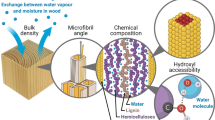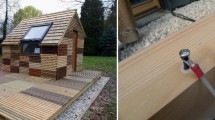Abstract
Relatively few studies have been performed on the equilibrium moisture content (EMC) of wood under conditions of elevated temperature and pressure. Eight studies indicated that EMC near saturation decreased between 100 and 150 °C, whilst five studies indicated that EMC increased. The aim of this study was to identify the likely source of the disagreement using radiata pine (Pinus radiata D. Don) sapwood which was conditioned to a moisture content of around 3 % and then exposed for 1 h at 150 °C and relative humidities of either 50, 70 or 90 %. Mean values of EMC, obtained through in situ gravimetric analyses, were 5.7, 7.6 and 12.6 % with 95 % confidence intervals of the order of 1 %. In two further experiments, the humidity was allowed to rise briefly above 90 % and the moisture content after 1 h was found to be >30 % as in the five studies that indicated EMC increased above 100 °C. The high moisture contents were attributed to condensation of liquid water on the specimen with subsequent evaporation at a rate that was too slow for the moisture content to reach equilibrium before it was measured. Reliable EMC data at elevated temperatures require (1) tight process control of experimental conditions with minimal standard error, (2) specimens with low initial moisture content to avoid unwanted wood mass loss over time, (3) a relative humidity upper limit that avoids drift above 95 %, and (4) extrapolation of data to humidity approaching 100 %.







Similar content being viewed by others
References
Simpson WT, Tenwolde A (1999) Forest products wood handbook: wood as an engineering material. USDA Forest Products Laboratory, USDA Forest Service, Madison, p 489
Hunter AJ, Tamasy-Bano M (2002) Wood Sci Technol 36:435
Eisenmann E (1950) Holz Zentralblatt 47:503
Kröll K (1951) Holz als Roh-und Werkstoff 9(6):216
Kauman WG (1956) Forest Prod J 6:328
Noack D (1959) Holz als Roh-und Werkstoff 17:205
Strickler MD (1968) Forest Prod J 18:69
Kollmann FFP, Côté WA (1968) Principles of wood science and technology. I: Solid wood. Springer, Berlin, p 592
Engelhardt F (1979) Holz als Roh-und Werkstoff 37:99
Resch H, Hoag ML, Rosen HN (1988) Forest Prod J 38:13
Shubin GS (1990) Doctoral Thesis. Lesnaia Promyshlennost Moskva, Moscow, p 154
Lee W, Abe H, Kuroda N (1998) Mokchae Konghak 26:1
Lenth CL, Kamke FA (2001) Wood Fiber Sci 33:104
Kubojima Y, Suzuki Y, Tonosaki M, Ishikawa A (2003) Holzforschung 57:634
Yamamoto T (1998) Available from Tabai Espec Corp, 3-5-6, Tenjinbashi, Kita-ku, Osaka, Japan. ESPEC Technology Report No. 5(1): 11. Anon (ed)
Ishikawa A, Kuroda N, Kato A (2004) J Wood Sci 50:7
Dinwoodie JM (2000) Timber: its nature and behaviour, 2nd edn. E & FN Spon, London, p 257
Keey RB, Langrish TAG, Walker JCF (1999) In: Timell TE (ed) Kiln-drying of lumber. Springer, Berlin, p 326
Anon (1999) Standard guide for moisture conditioning of wood and wood based materials. American Society for Testing and Materials, D4933-99
Pearson H (2010) Material properties and stress modelling of radiata pine at high temperature. Doctoral Thesis, University of Waikato, Hamilton, p 481
Hill C (2006) In: Stevens CV (ed) Wood modification: chemical, thermal and other processes. Wiley, West Sussex, p 239
Pearson H, Gabbitas B, Ormarsson S (2012) Holzforschung 66:659
Kininmonth JA, Whitehouse LJ (1991) New Zealand radiata pine. Vol. I: wood properties. New Zealand Forest Research Institute, Rotorua, p 232
Pearson H (2004) A dew point sensor. Provisional patent 531044. New Zealand Forest Research Institute Limited, Rotorua, p 18
Gere JM, Timoshenko SP (2000) Mechanics of materials, 5th edn. Brooks Cole, Pacific Grove, p 928
Beall FC (1969) Wood Fiber Sci 1:215
Stamm AJ (1956) Ind Eng Chem 48:413
Hunt DG, Gril J (1996) J Mater Sci Lett 15:80
Pearson H, Gabbitas B, Ormarsson S (2011) Creep and mechanosorption of wood at high temperature. COST Action FP0904 workshop. Mechano-chemical transformations of wood during thermo-hydro-mechanical processing, Biel/Bienne, Switzerland, 16–18 February 2011
Almeida G, Hernandez RE (2006) Wood Fiber Sci 38:74
Stamm AJ (1971) Wood Sci 4:114
Salin J (2010) The future of quality control for wood and wood products, COST Action E53, Edinburgh, Scotland, UK, 4–7 May 2010
Engelund ET, Thygesen LG, Hoffmeyer P (2010) Holzforschung 64:325
Hoffmeyer P, Engelund ET, Thygesen LG (2011) Holzforschung 65:875
Cloutier A, Fortin Y (1991) Wood Sci Technol 25:263
Kelsey KE (1957) Austral J App Sci 8:42
Hailwood AJ, Horrobin S (1946) Trans Faraday Soc 42B:84
Acknowledgements
The authors would like to thank the New Zealand government for research funding and acknowledge all those at Scion who assisted during the course of this study especially Dr Bernard Dawson and Dr Roger Newman.
Author information
Authors and Affiliations
Corresponding author
Rights and permissions
About this article
Cite this article
Pearson, H., Gabbitas, B. & Ormarsson, S. Equilibrium moisture content of radiata pine at elevated temperature and pressure reveals measurement challenges. J Mater Sci 48, 332–341 (2013). https://doi.org/10.1007/s10853-012-6750-2
Received:
Accepted:
Published:
Issue Date:
DOI: https://doi.org/10.1007/s10853-012-6750-2




